As an Amazon Associate I earn from qualifying purchases.
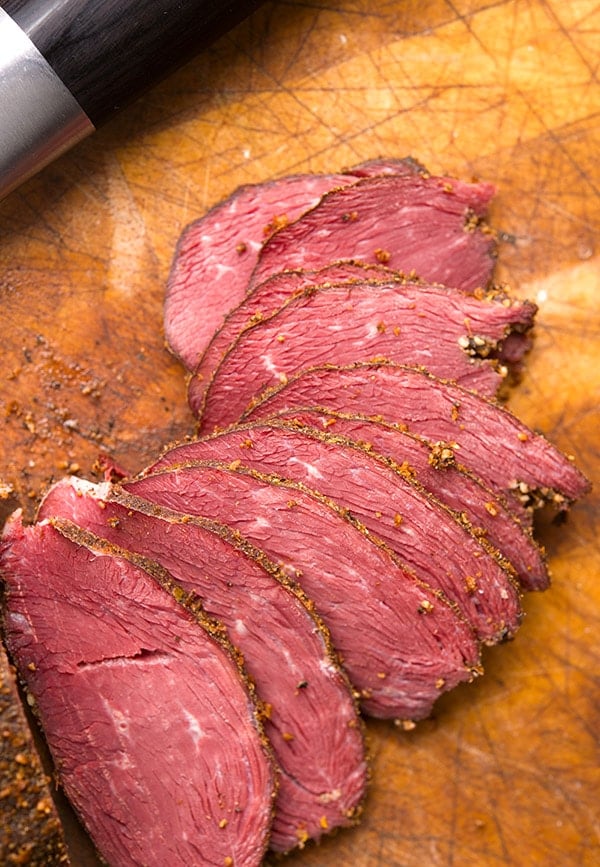
Goose pastrami is what I do with most of my Canada goose breasts. It is an easy project that makes the most out of these often-tough slabs of meat.
Why geese? Well, Canada and snow geese are very close to grass-fed beef in flavor (they eat the same thing), they have large, easy-to-work-with breasts, and they do have a tendency to be tough, which means that any way you can cook them that lets you slice the breasts thinly is a good thing.
Pastrami, in case you’ve never had it, is a cured meat from Eastern Europe or Turkey — remember the Ottomans ran Eastern Europe for a while — that’s normally beef or mutton. Although here’s an interesting tidbit from Wikipedia: “Among Jewish Romanians, goose breasts were commonly made into pastrami because they were inexpensive.”
So there ya go. This is traditional!
To make pastrami, you dry cure (sometimes brine) the meat for a few days, dry it a bit, coat it in the characteristic black pepper and coriander and then smoke it. Sliced thin on a sandwich, it’s God’s gift. Good pastrami at a Jewish deli is something you must eat at least once before you die.
If you have any goose breasts in your freezer, go for it. A pastrami on rye with good mustard, a slice of cheese and maybe some sauerkraut, and you got yourself some awesome there!
Once you make your pastrami, it will need to be eaten within a week or two, or you’ll need to vacuum seal and freeze it.\
Goose Pastrami
Ingredients
- 2 skinless Canada goose (or domestic goose breasts
- Kosher salt see recipe notes
- 3 grams Instacure No. 1, good for up to 3 pounds of goose
- 1/2 teaspoon dried thyme
- 1/4 teaspoon celery seed
- 1/4 teaspoon caraway seed
- 1 teaspoon sugar
- 1/4 teaspoon crushed juniper optional
- 1 teaspoon ground black pepper plus 1 tablespoon ground black pepper
- 1/4 cup brandy red wine, vinegar or water
- 1 tablespoon ground coriander
Instructions
- Weigh your goose breasts. For every pound of goose, you'll need 10 grams of kosher salt, which is about a tablespoon. It's OK if you are a little off on this measurement. Mix the salt, curing salt, sugar as well as the thyme, celery seed, caraway, juniper and the teaspoon of black pepper and grind them all together in a spice grinder. Pack the goose breasts with this mixture, massaging it into the meat. Put the goose into a closed container in the fridge for 24 to 72 hours.
- When you are ready, rinse off the goose and pat it dry. It's fine if you have a little bit of the cure stuck to the meat, but you don't want too much. Put the goose breasts on a rack in the fridge and let them dry uncovered for a day.
- Dip the goose into the brandy -- or really any other liquid you want -- and then coat thoroughly in the remaining black pepper and ground coriander seed. I like to grind this myself so the texture is a little coarse, a little fine.
- Smoke the goose breasts until the interior hits 140°F, which takes me about 3 hours.
- Let the goose pastrami cool and eat as lunch meat, or on crackers or whatever.
Notes
Nutrition
Nutrition information is automatically calculated, so should only be used as an approximation.
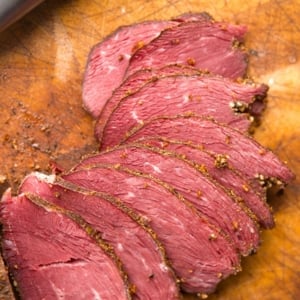
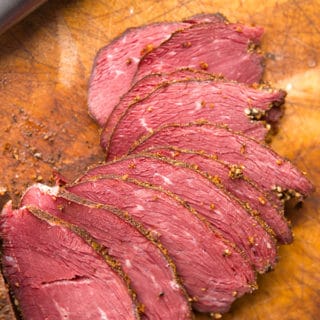

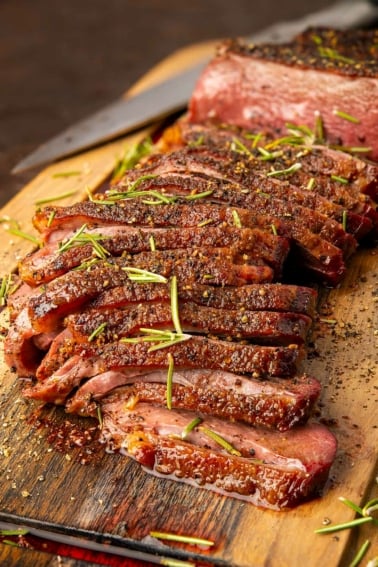
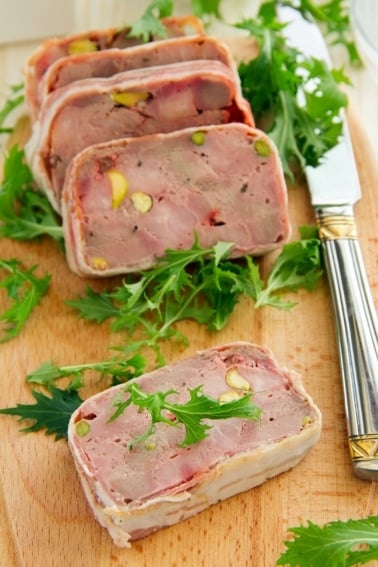

This is my favorite recipe for skinny late season Canada Geese.
I made this and my wife left it out over night. The pastrami was sliced thin and vac sealed. Do you think it would be eatable after that time? Does the cure and smoke help in preserving the meat in any way that it would have a chance of being protected? It turned out so good I would hate to have to throw it out.
Jacob: I don’t know. I’d be leery of it.
How long can it stay vac sealed and unrefrigerated? I’d like to mail some to a buddy cross country.
Sal: Um, not long. If you did, I’d freeze it first then send it overnight.
If finishing in the oven, what temp and for how long would be good to get it to temp? Thanks.
Jimbo: I’d go low, like 225F, and I am not sure on time. Use a probe thermometer to get it to about 140F internal.
Hank, I notice the only ingredient that varies depending on weight is the kosher salt. My question is if you have less meat, say 1 or 2 lbs instead of 3, would you keep all the ingredient amounts the same for the cure rub and only adjust the kosher salt based on the weight? I am thinking that as long as the ratio is right with the other ingredients, besides the kosher salt, that it would be ok still for a smaller amount of meat since whatever is left after the rub of the cure wont be making it into the meat and just be discarded? Really my concern is with how much instacure to use with smaller amounts and hoping that as long as I mix up to this ratio I wont have to actually adjust the amount I’m putting in the rub, just sometimes I will not use all the rub if I have less than 3 lbs and sometimes i will if i have the 3lbs.
Jim: Yes, if you keep all the ratios the same you can scale this up or down at will.
Curious if I can cold smoke it say for 4 hours, then put it in the oven and bring it up to temp? Thanks
Robert: That would work.
Has anyone frozen a breast after curing and smoking? How does the meat turn out after being frozen for ~6 mo? too dry? Looking forward to trying this. Thanks
Brett: Yes, it works very well.
Heyo – would this recipe also work well for wild duck breast? I made a load of this last season with goose and it turned out great, but I’ve got freezer full of duck from this past season, so would like to try something for that as well. TIA.
KB: Yes, but they will be very small.
While not recommended, I did this with specks and snows since that is what I had at the end of the season. I think I might increase the spices in the curing process a little next year. I smoked this to 145 over hickory (3 hr at 160-170). Mighty tastey!
I also did this to the legs and plan to shred those into a reuben casserole of sorts.
Can you make this without instacure?
Cameron: yes, but it will not be rosy red. It will be gray.
This is one of my go to uses for Canada goose breasts. I have been making it every year for about 5-6 years now. This year I did something a little different. I kept the skin on and stuffed 2 breast chunks together, meat side in, skin side out, into sausage netting. I smoked it to about 136 internal, rested, then sliced it as thin as I could with a large fillet knife. Then I tossed all the sliced pastrami in the black pepper/coriander mix. There was enough moisture there that it adhered really well. I really loved it this way. Vac sealed into 1 lb packages for my next fishing trip. Can’t wait!!
Like many hunters, I find it more enjoyable to shoot Canada geese than eat them. Or I use to, before I found this recipe. Every single person I have served this to has said that it was the best pastrami they’ve ever had. Not best goose pastrami. Best pastrami. And I’ve mostly served this to folks that shutter at the thought of eating wild game. Can’t thank you enough for this one Hank.
Recipe notes: before I could find juniper berries, I replaced them in the recipe with good gin. The gin gave it a little hint of juniper, but I prefer using the berries (which are easy to procure online). I also highly recommend toasting the caraway, juniper berries, and peppercorns before grinding (not the caraway) and including. Finally, Hank, it would be great to have metric weight versions of all your recipes.
Just finished my first batch of this yesterday. I have tried a couple of other goose pastrami recipes and they were very good. But this is my favorite so far. I modified it slightly so I could use an equilibrium brine and have more control over the salt content so I can’t speak as to how salty the original recipe is. But the flavor profile is spot on.
The Juniper might be optional, but it is highly recommended. It adds a great little flavor that most people are unaccustomed to, but end up enjoying.
Using the equilibrium brine I was able to get great results on both skin-off and skin-on breasts. And I actually prefer the skin on version. Especially with my late season geese that had a nice layer of fat.
Thanks for the recipe Mr. Shaw!
I’ve made this recipe twice, and it’s been too salty both times. The second time, I cut the soak time back to ten hours. I would next cut the amount of salt in the brine by 50% and replace with sugar.
Made this recipe with a couple of fresh Canada Goose breasts right out of the field and I am SO delighted! I didn’t have coriander seed so substituted cumin which worked perfectly.
Smoked about 3 hours with cherry, finished bringing it to 145 internal in the oven set to 200.
Wish I could post a photo, the colour is amazing!
I need to get some Swiss cheese and 1000 Island dressing, then it will be Reubens on homemade sourdough bread.
Thanks for a great recipe!
With regard to the comment about using Tenderquick, my understanding it has a much lower concentration of nitrates than the instacure #1, hence the longer curing time.
But back too the basic recipe. I have a batch of snow goose breasts (our group killed 347 of those filthy animals yesterday) I want to make into pastrami and am curious how to scale the recipe. Is the basic recipe above good for 3 lbs. of goose and if, say I have 9 lbs of goose, could I triple it (keeping with the 1.25 grams of cure per lb. ratio)?
Mark: Yep, that’s right.
Hank: I just wanted to thank you, not just for this recipe, but for all you do to promote your love of culinary excellence with the waterfowl and upland birds I hunt. Your book, “Duck, Duck, Goose” is amazing, and I can’t wait to receive my pre-order of your latest work, “Pheasant, Quail, Cottontail.” I have made this pastrami recipe twice now with Canadas and think it is perfect. I use bourbon! Thanks again! – James M.
I don’t see the amount of kosher salt in the recipe…. also it seems like pink curing salt is the same as Instacure #1… is that correct?
Bob: It’s in there. Read the recipe. And yes, pink curing salt is generally, but not always, the same thing as Instacure No. 1.
Hank,
Love this recipe! On my 3rd round. How long can I keep in fridge?
Nicholas: I’d say about a week.
Thanks for the reply Hank! I weighed the breasts and used your recommendation of 22 grams Kosher salt per pound of meat. By my calculations, however, that is more like 4.8% salt (22 grams divided by 454 grams/lb.). Maybe I’ll just try less salt.
HI Hank, I tried the recipe this weekend. Cured 4 whole breast pieces for about 36 hours. Rinsed, dried for 24 hours, then smoked for about 4 hours. The pastrami is good, but very, very salty. Any suggestions for how to reduce the saltiness? Shorter curing time?
Mark
Mark: Did you go by weight or volume? That can be a problem if your salt is cut smaller than mine. Also, it depends on the size of the goose breasts. Very hard to pin down, but a good ratio is 2% salt by weight.